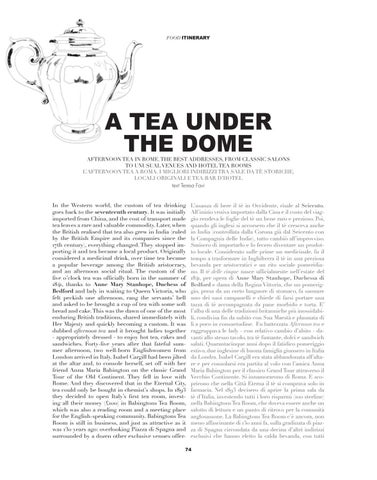FOOD ITINERARY
A TEA UNDER THE DOME
AFTERNOON TEA IN ROME. THE BEST ADDRESSES, FROM CLASSIC SALONS TO UNUSUAL VENUES AND HOTEL TEA ROOMS L’AFTERNOON TEA A ROMA. I MIGLIORI INDIRIZZI TRA SALE DA TÈ STORICHE, LOCALI ORIGINALI E TEA-BAR D’HOTEL text Teresa Favi
In the Western world, the custom of tea drinking goes back to the seventeenth century. It was initially imported from China, and the cost of transport made tea leaves a rare and valuable commodity. Later, when the British realised that tea also grew in India (ruled by the British Empire and its companies since the 17th century), everything changed. They stopped importing it and tea became a local product. Originally considered a medicinal drink, over time tea became a popular beverage among the British aristocracy, and an afternoon social ritual. The custom of the five o’clock tea was officially born in the summer of 1841, thanks to Anne Mary Stanhope, Duchess of Bedford and lady in waiting to Queen Victoria, who felt peckish one afternoon, rang the servants’ bell and asked to be brought a cup of tea with some soft bread and cake. This was the dawn of one of the most enduring British traditions, shared immediately with Her Majesty and quickly becoming a custom. It was dubbed afternoon tea and it brought ladies together - appropriately dressed - to enjoy hot tea, cakes and sandwiches. Forty-five years after that fateful summer afternoon, two well-born Englishwomen from London arrived in Italy. Isabel Cargill had been jilted at the altar and, to console herself, set off with her friend Anna Maria Babington on the classic Grand Tour of the Old Continent. They fell in love with Rome. And they discovered that in the Eternal City, tea could only be bought in chemist’s shops. In 1893 they decided to open Italy’s first tea room, investing all their money (£100) in Babingtons Tea Room, which was also a reading room and a meeting place for the English-speaking community. Babingtons Tea Room is still in business, and just as attractive as it was 130 years ago: overlooking Piazza di Spagna and surrounded by a dozen other exclusive venues offer-
L’usanza di bere il tè in Occidente, risale al Seicento. All’inizio veniva importato dalla Cina e il costo del viaggio rendeva le foglie del tè un bene raro e prezioso. Poi, quando gli inglesi si accorsero che il tè cresceva anche in India (controllata dalla Corona già dal Seicento con la Compagnia delle Indie), tutto cambiò all’improvviso. Smisero di importarlo e lo fecero diventare un prodotto locale. Considerato sulle prime un medicinale, fu il tempo a trasformare in Inghilterra il tè in una preziosa bevanda per aristocratici e un rito sociale pomeridiano. Il tè delle cinque nasce ufficialmente nell’estate del 1841, per opera di Anne Mary Stanhope, Duchessa di Bedford e dama della Regina Vittoria, che un pomeriggio, presa da un certo languore di stomaco, fa suonare uno dei suoi campanelli e chiede di farsi portare una tazza di tè accompagnata da pane morbido e torta. E’ l’alba di una delle tradizioni britanniche più inossidabili, condivisa fin da subito con Sua Maestà e plasmata di lì a poco in consuetudine. Fu battezzata Afternoon tea e raggruppava le lady - con relativo cambio d’abito - davanti allo stesso tavolo, tra tè fumante, dolci e sandwich salati. Quarantacinque anni dopo il fatidico pomeriggio estivo, due inglesine di buona famiglia giunsero in Italia da Londra. Isabel Cargill era stata abbandonata all’altare e per consolarsi era partita al volo con l’amica Anna Maria Babington per il classico Grand Tour attraverso il Vecchio Continente. Si innamorarono di Roma. E scoprirono che nella Città Eterna il tè si comprava solo in farmacia. Nel 1893 decisero di aprire la prima sala da tè d’Italia, investendo tutti i loro risparmi (100 sterline) nella Babingtons Tea Room, che doveva essere anche un salotto di lettura e un punto di ritrovo per la comunità anglosassone. La Babingtons Tea Room c’è ancora, non meno affascinante di 130 anni fa, sulla gradinata di piazza di Spagna circondata da una decina d’altri indirizzi esclusivi che hanno eletto la calda bevanda, con tutti
74


















